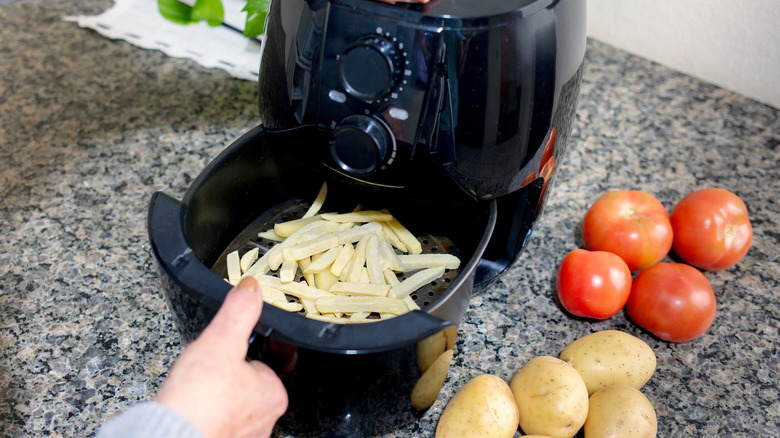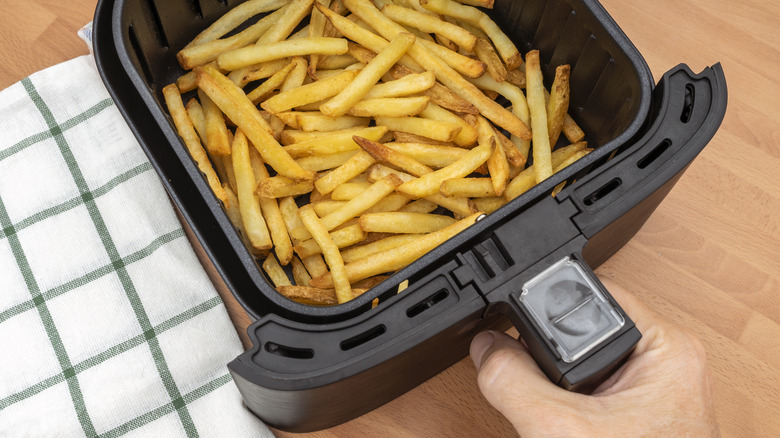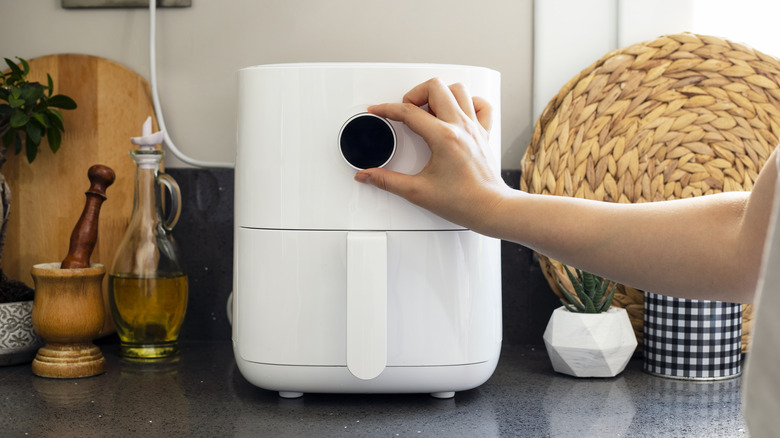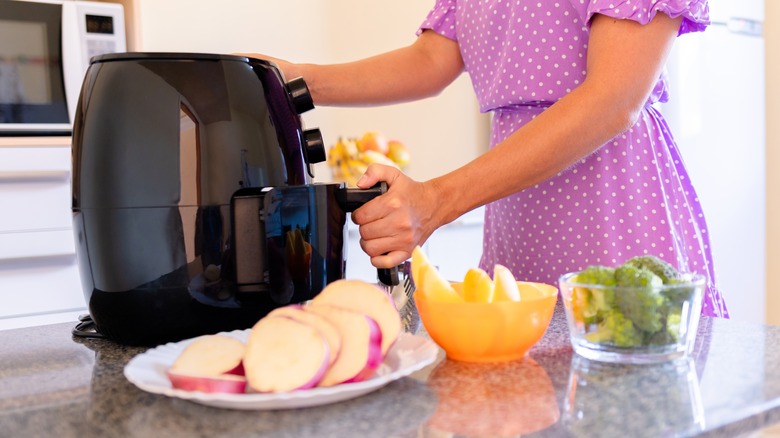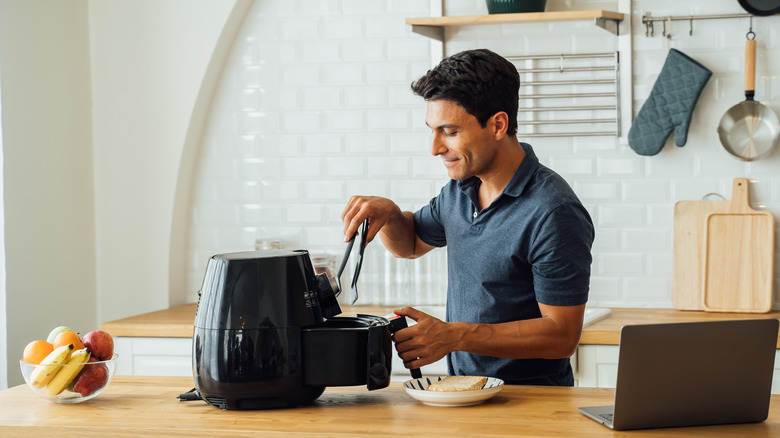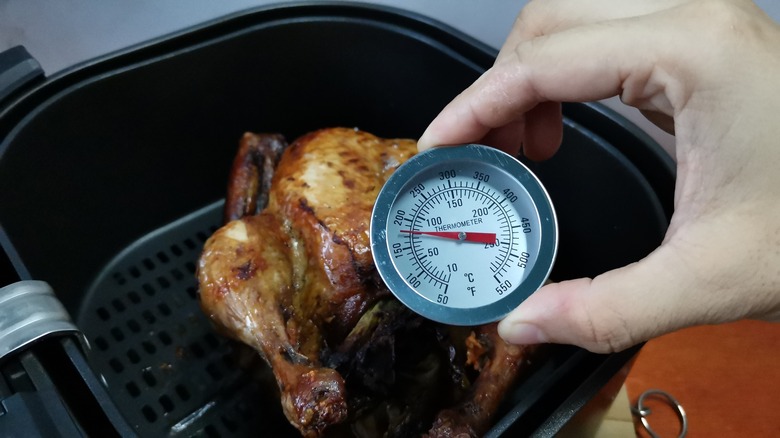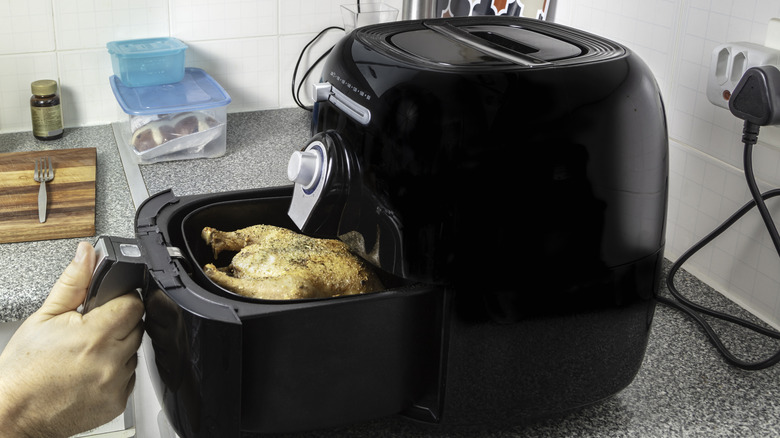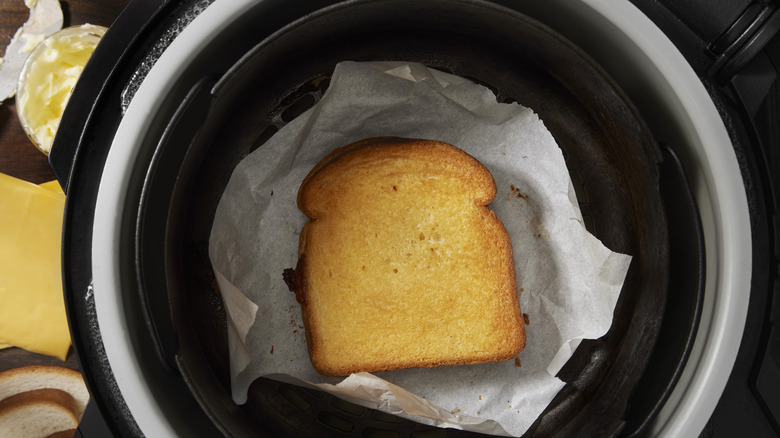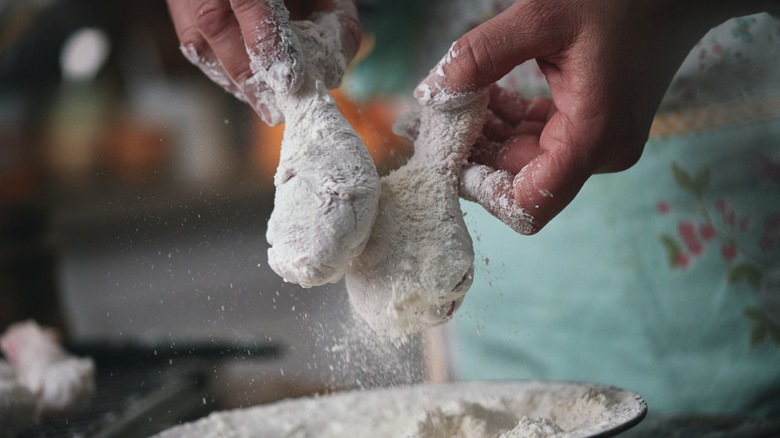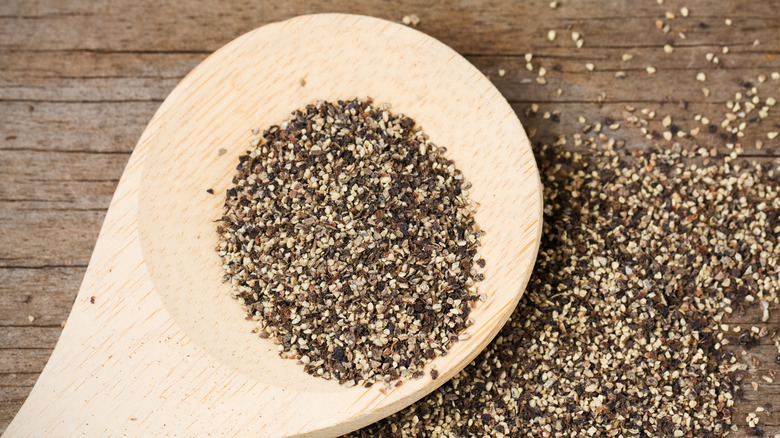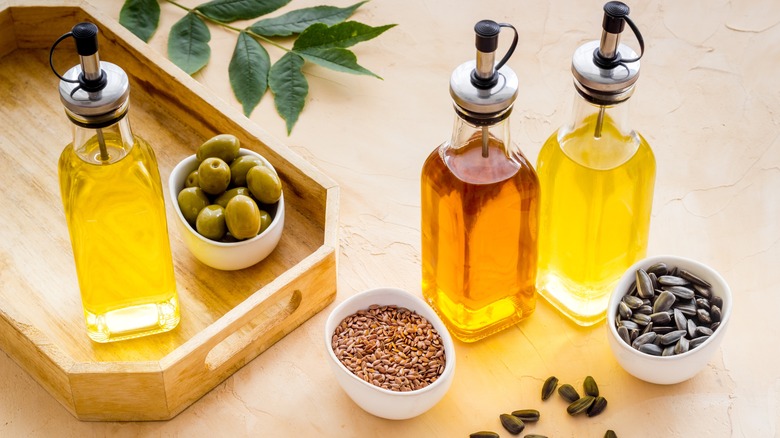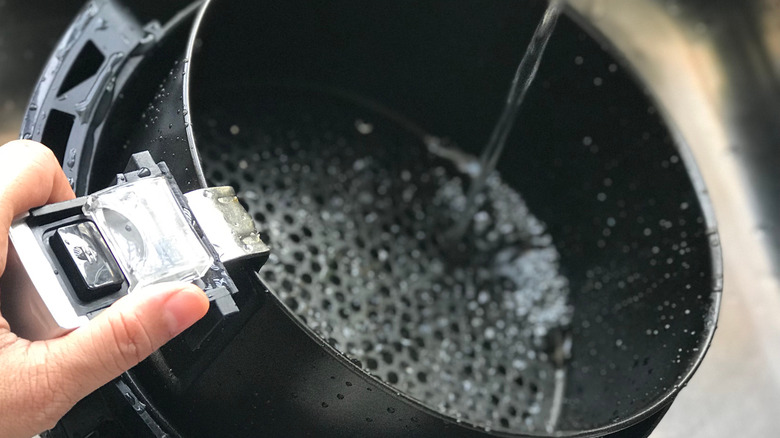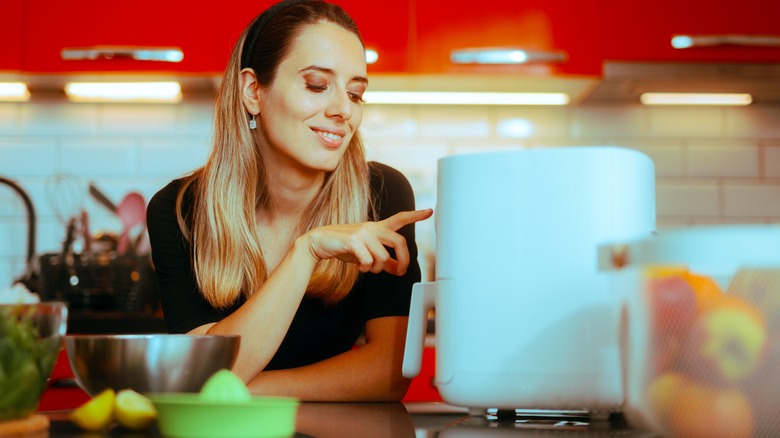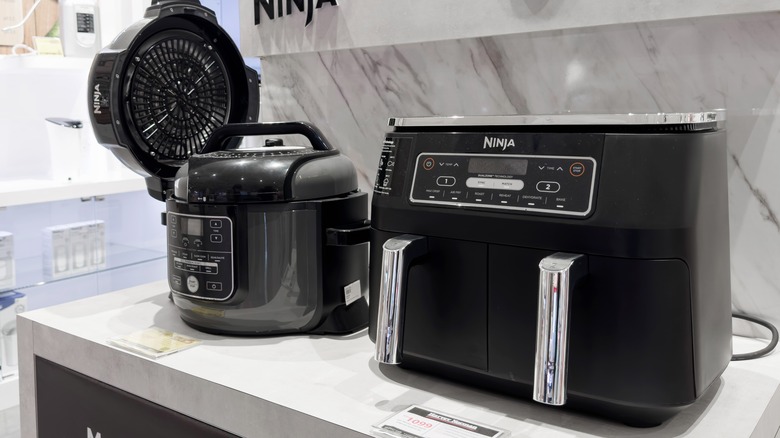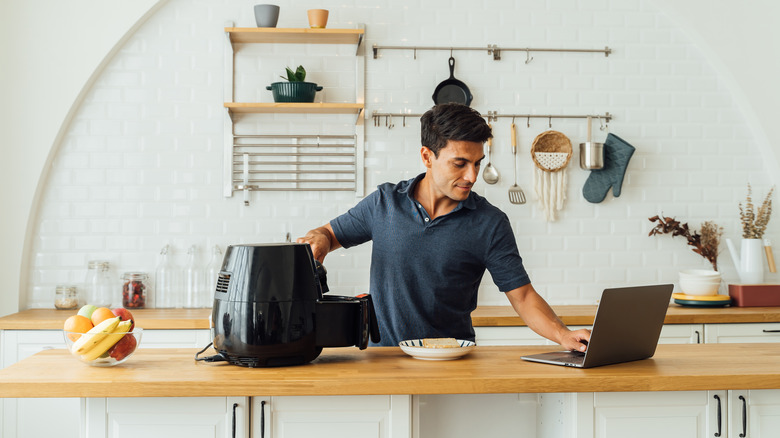Stop Making These Big Mistakes With Your Air Fryer
Air fryers generated a lot of hype when they first appeared on the culinary scene, and it's easy to understand why. The spaceship-shaped appliances promise crispy chicken wings without the grease splatter, perfectly roasted veggies in minutes, and golden brown fries with a fraction of the fat. If you jumped on the air fryer bandwagon only to be disappointed by limp fries and a smoky kitchen, you're not alone. Like any kitchen appliance, air fryers are only effective when they're used correctly. Most inexperienced home cooks fall prey to the same common air fryer mistakes. From forgetting to preheat your appliance to not using the right accessories, these mishaps can ruin even the best recipes.
The good news for home cooks? Air frying is an easy cooking technique that just about anyone can master in no time — that's one of the reasons air fryers skyrocketed in popularity. Take a few minutes to learn about the mistakes you're probably making when you turn on your air fryer, and how to avoid them. Say goodbye to soggy potatoes and rubbery vegetables and learn how to make amazing air-fried meals that actually live up to the hype.
1. Overcrowding the air fryer basket
The volume capacity of an air fryer is much smaller than most conventional deep fryers or baking pans. Before you pile in enough sliced potatoes or chicken wings to feed a small nation, stop to consider how a full-to-bursting basket will impact the taste and texture of your meal. Overcrowding your air fryer basket is a surefire way to sabotage crispiness and end up with a soggy, unevenly cooked mess. Let's break down the science: Air fryers work by circulating hot air around your food, mimicking the effects of deep-frying without most of the fat. Each piece needs to come in contact with the moving air to achieve perfect edges and even cooking. Cram your food in like sardines and your food ends up steamed instead of air-fried. That probably isn't what you were after when you added an air fryer to your culinary toolbox. Overcrowded air fryer baskets are also more likely to spill and splatter, creating more mess and hassle.
Whether you're making homemade croutons, crispy vegetables, or french fries, it's best to give each morsel of food the space it deserves. This might mean cooking in two or three batches, depending on the size of your air fryer and the quantity you're making. Don't sweat the extra step; you'll be rewarded with crispier food and happier dinner guests.
2. Not preheating your air fryer
You wouldn't put a cake into a cold oven and expect delicious results. So why are you tossing meat or veggies into an air fryer without cranking up the heat first? Air fryers take less time than conventional ovens to heat up, but that doesn't mean you can skip the preheating step altogether. Think of it like this: imagine tossing your food onto a lukewarm frying pan. The oil wouldn't be hot enough for that instant sizzle, leading to unevenly cooked meat and unseared edges. Similarly, a cold air fryer basket won't deliver the immediate blast of heat needed for that signature air-fried texture. Preheating ensures the temperature is already at your desired setting, so your food hits that hot air right away. This sears the surface, locking in juices and creating that irresistible crispy exterior.
Now, there are some exceptions to the preheating rule. For meats that need to be cooked for a long period, like whole chicken or pork roast, preheating isn't necessary. Baked potatoes and whole squash are two other examples of foods that will come out just fine in the air fryer if you skip the preheat.
3. Not using any oil
Remember that chicken breast recipe that came out of the air fryer looking like dry jerky? A light olive oil drizzle could have saved it. Air fryer recipes require less fat than pan frying or deep frying but you still need some oil for moisture, texture, and flavor. Fresh, unprocessed foods like veggies, lean meats, and tofu all benefit from the addition of oil which promotes browning and caramelization. Oil also acts as a moisture barrier, preventing delicate proteins like fish from drying out. In short, if you want crispy golden fries, juicy, tender meats, and flaky fish filets, don't skip the oil.
Another major reason to use oil in your air fryer recipes? It keeps your food from getting stuck in the crevices of the air fryer basket. If you're worried about the extra calories, keep in mind that a little oil goes a long way in the air fryer. In most cases, a small spoonful or spritz is all you need to do the job.
4. Forgetting to flip or toss your ingredients
Some air fryer newbies mistakenly believe that the powerful fan in air fryers eliminates the need for tossing or flipping ingredients during cooking. The truth is that the circulation of hot air alone isn't enough to ensure even cooking and restaurant-quality results. Just like oven cooking, the bits of food directly facing the heat source get the most direct exposure to the heat. That's why it's key to give your ingredients a little toss, flip, or shake midway through the air frying process. The exact technique you'll use will depend on your recipe, but a quick flip of a pork chop or jiggle of a basket of Brussels sprouts helps ensure every bite gets equal exposure to moving hot air.
Flipping and tossing isn't just about even browning. They also help prevent sticking, a common air fryer woe. Have you ever had your crispy chicken wing skin get stuck to the bottom of your fryer basket? A shake mid-cook releases them and prevents them from turning into a sticky, one-sided mess. Plus, it helps render fat more evenly, leading to juicier results and less chance of dry, flavorless bites.
5. Failing to checking meat temperature
Before you dig into a perfectly seasoned, golden brown plate of air-fried chicken thighs, there's one crucial step you can't skip: checking the internal temperature. Even meats that look browned and cooked on the outside, can remain undercooked on the inside, which is where foodborne illness rears its ugly head.
Your recipe's recommended cooking time is a good starting place for determining how long to cook meat in the air fryer but it shouldn't be the only gauge you use. Grab your trusty food thermometer and double-check the internal temperature of your chicken, beef, pork, and fish. It's an essential step to ensuring everyone around the table enjoys a safe and satisfying meal. Different meats have different safe internal temperatures ranging from 145 F for ham, pork, and steaks to 165 F for poultry. Hitting these temperatures is critical, so you shouldn't leave this to chance or guesswork.
6. Using the same setting for every recipe
Most air fryers come with a variety of built-in settings for different culinary needs. The default "air fry" setting should be your go-to for achieving that signature crispy-on-the-outside, tender-on-the-inside texture like fries, battered wings, and frozen snacks. But if you're not adjusting your air fryer's settings for other dishes, you're not enjoying the full potential of this handy countertop appliance. Turn the dial of your air fryer to "bake" for baked goods like muffins, scones, and even small cakes. The bake setting is also best for making small batches of roasted vegetables, as it mimics the functionality of a traditional convection oven. Save the roast setting for roasting pork, beef, or chicken — air fryers can roast these larger cuts of meat in less time than your oven.
Remember that air fryer settings are just a starting point. In most cases, each setting can be adjusted to suit a specific recipe or desired outcome. If your air fryer doesn't come with a variety of automatic settings, you can achieve the same results by manually adjusting the time and temperature according to your air fryer's user manual.
7. Not using a drip tray or liner
Love air frying but hate scrubbing your air fryer basket? You need to use a liner. Lining your air fryer basket before cooking makes clean-up a breeze and keeps your air fryer from getting grimy. Parchment paper makes an easy and inexpensive disposable liner if it's cut to the size and shape of your appliance. You can also use tin foil in an air fryer basket for most air fryer recipes. Whichever you use, make sure to poke holes in the bottom of the liner first. Otherwise, you block airflow and prevent the air fryer from working its crisping magic. To make life even easier, you can purchase special liners specifically designed for use in air fryer baskets.
If your air fryer contains metal racks inside like a toaster oven, odds are good it came with a removable drip tray accessory. Keep the drip tray installed whenever you're using the air fryer to catch stray morsels of food and oil. Instead of scrubbing the floor of your air fryer after every use, just slide out the drip tray and wash it with your other dishes. Along with keeping your air fryer shiny and clean, drip trays prevent crumbs from becoming burned onto the appliance which can affect the taste of your food, and omit a smokey, burnt smell every time you switch on the air fryer.
8. Using wet batter
When it comes to cooking breaded chicken and other battered dishes in the air fryer, choosing the right style of batter is key to achieving a perfect crunch. Classic wet batters made with a combination of eggs and flour can become a soggy mess in the air fryer. Traditional wet batters rely on the hot oil of deep frying to set quickly and create a crispy barrier. But in the air fryer's dry heat without constant contact with oil, the wet better runs the risk of sliding off of your food and becoming sticky instead of crunchy. While there are ways to successfully use some wet batters in the air fryer, the process has a steep learning curve and often ends in disappointment.
Avoiding putting wet batter in your air fryer doesn't mean you have to give up your dreams of whipping up low-fat versions of your favorite fried breaded foods. You just need to use batters with less moisture. Dry batters made with a combination of flour or panko breadcrumbs and seasoning work wonders in the air fryer.
9. Adding coarse seasoning
The right sprinkle of seasoning has the power to elevate food from mediocre to mouthwatering. Before you reach for your go-to spice blends, make sure you're not using overly coarse seasonings in your air fryer recipes. Those large chunks of peppercorns or bits of rosemary have a mind of their own in the air fryer's whirlwind of hot air. They're likely to end up concentrated in some areas, leaving others bland. Coarser spices simply don't stick to food as readily as their more finely ground counterparts. This means those sprigs of thyme or whole cumin seeds may end up clinging to your air fryer's basket liner rather than your spears of cauliflower. In worst-case scenarios, super coarse spices may get burnt into the crevices of your air fryer, creating a burnt smell and potential fire hazard.
Instead, reach ground spices and finely crushed dried herbs for air-fried foods with flavor in every bite. Use a spice grinder to process your whole peppercorns or coriander seeds into a finer powder before sprinkling them over your next batch of air-fried meats or veggies.
10. Using the wrong oil
Cooking oil plays a crucial role in the flavor and texture of air-fryer cooking. The type of oil you use is just as important. Air fryers cook foods at temperatures ranging from 350 F to 400 F (and in some cases, even higher). You need oils with a high smoke point to withstand these high temperatures. An oil's "smoke point" refers to the temperature at which it begins to burn, sputter, and release an unpleasant bitter flavor into your food. Canola oil, peanut oil, avocado oil, and other vegetable oil cooking blends tend to be your best bet for air fryers with smoke points exceeding 400 F.
Steer clear of using extra virgin olive oil in most air fryer recipes. When this more delicate oil is exposed to quick blasts of high heat in the air fryer, it can burn in the blink of an eye leaving your food tasting burnt, bitter, and smoky. Flaxseed oil and walnut oil are two more oils to avoid adding to foods before air frying. Instead, reserve these low-smoke point oils as additions to your already-cooked dishes to add flavor and moisture.
11. Only washing the air fryer basket
Taking care of your air fryer involves more than just rinsing out the basket after every use. Too many air fryer owners neglect to regularly give their magic cooking assistant a more thorough scrub. Proper washing isn't just about aesthetics, it's about preserving your air fryer's function, protecting your health, and ensuring that every batch of air-fried fish or roasted carrots tastes as delicious as possible. Every time you use your air fryer, flecks of oil, crumbs of breading, and bits of seasoning get blown around and settle into a grimy layer. That layer creates a graveyard of the ghosts of meals past that can come back to haunt you the next time you flip on your air fryer. You don't want rancid bits of chicken or burnt flecks of potato skin making their way into your food, so wiping down your air fryer walls and trays after every use is a must.
Use a damp sponge with mild dish soap to wipe down both the interior and exterior of the air fryer chamber. Got stubborn bits of food stuck in the nooks and crannies? Grab a bristled brush and a little elbow grease to work through the grime and get your air fryer back in sparkling shape.
12. Depending too much on the timer
The built-in timer function on an air fryer is another feature users love — and often misunderstand. Because your air fryer will automatically turn off when its preset cook time has ended, it's easy to become too dependent on it. While this feature is convenient and certainly reduces the risk of burning or fire, your air fryer timer isn't foolproof. Variables like the size of your air fryer, the make-up of your ingredients, and even your climate can affect cooking time. And because air fryers can reach high temperatures in no time, home cooks who are new to the method may end up burning or overcooking food by accident.
Even if you're using a recipe designed for your specific brand of air fryer, you should still be prepared to adjust the cooking time to achieve optimum air frying results. Use your recipe's suggested cooking time as a starting point, then check your food periodically for signs of doneness. As you become more familiar with the quirks of your particular air fryer, you'll become more confident in choosing the cooking times you need for air-fried success.
13. Choosing the wrong size air fryer
Choosing the right size and type of air fryer is a critical step. With so many models on the market these days, take the time to consider which air fryer is best for your cooking needs. If you're cooking meals for one or two people at a time, a compact two-quart model will happily handle solo snacks and cozy dinners for two. On the other hand, folks with large families and dinner party enthusiasts should probably opt for a larger model with at least a five-quart capacity. If your air fryer is too small for your needs, you'll find yourself constantly air frying in batches — canceling out the time-saving benefits air frying offers.
Size isn't the only factor to take into consideration when choosing an air fryer. Take the time to think about how versatile you need your model to be. Classic models with a drawer basket are fabulous for blasting out the high heat but don't have as many extra settings and cook modes as other models. If you have limited counter space and want an all-in-one appliance, you may be happier with a hybrid toaster oven-style air fryer. These beasts can toast, bake, broil, and even slow roast meats on a rotisserie. Choosing an air fryer that suits your lifestyle and cooking preferences will leave you happier and more satisfied with your investment.
14. Not using the right recipes
Plenty of air fryer novices mistakenly think they can use any recipe for air fryer cooking. This leads to confusion, frustration, and disappointment when their inaugural air-fried meals don't turn out as expected. That's because air-frying requires different ratios, cooking times, and temperatures than oven baking, pan frying, and deep frying. For one thing, air fryers pack a punch of more concentrated heat than ovens. This means you generally use a lower temperature for air frying than you would for oven baking. Failing to adjust the temperature can lead to food that's burned on the outside and undercooked on the inside.
As you get more familiar with the ins and outs of air frying, you'll gain more confidence in adapting recipes for air frying. But when you're just getting started with this trendy cooking method, stick with recipes specifically developed for the air fryer. If you want even more precise results, use recipes that have been tested for use in the same model of air fryer you own.
